Our aging blood
The quest to address how age-related mutations drive blood cancers
September 30, 2021 | Leigh MacMillan
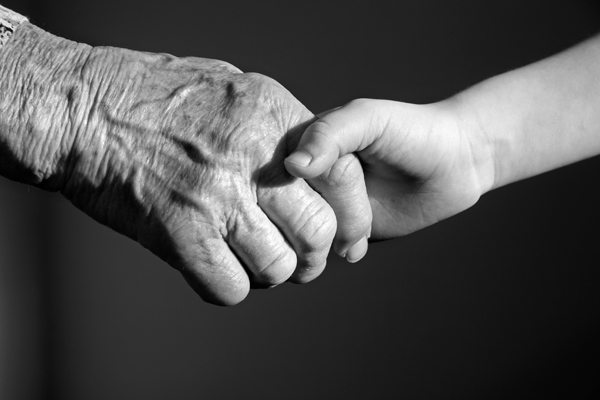
Photo by Adobe Stock
Lianfei Xu and her husband were just weeks away from traveling to their native China to visit family in the fall of 2014 when she learned that her dad hadn’t been feeling well and was going into the hospital to have some tests.
“We were planning to visit my husband’s family on the other side of the country first, and my dad said, ‘It’s no big deal; I’ll be back at home by the time you get there,’” Xu remembers.
But her dad’s health declined, and about a week before the trip, he was diagnosed with myelodysplastic syndrome (MDS). Xu and her husband changed their itinerary to visit her family first.
“We got to China on October 12th, and my dad passed away on the 14th,” Xu says. “It was really, really terrible. I was so lucky to be with him the last two days.”
At the news of the diagnosis, Xu began searching for information about MDS.
“This thing was driving me nuts. I’d never heard of MDS,” says Xu, who lives in Brentwood, Tennessee.
MDS is a type of cancer in which blood-forming cells in the bone marrow become abnormal and do not produce enough healthy blood cells. About one-third of patients with MDS develop the fast-growing blood cancer, acute myeloid leukemia (AML).
Although it is uncommon for patients to die so soon after an MDS diagnosis, both MDS and acute leukemia are complex problems, with therapies that “aren’t good enough,” says hematologist Michael Savona, MD, professor of Medicine and holder of the Beverly and George Rawlings Directorship.
Savona and his team are developing new treatments for leukemia, MDS and other blood cancers that provide longer and better quality of life for patients, and their ultimate aim is to stop these diseases before they start.
“Once someone has acute leukemia or myelodysplasia, it’s kind of like the horse is already out of the barn,” Savona says. “What we want to do is find people at high risk earlier and earlier and prevent them from getting the disease in the first place.”
It’s an audacious goal, he admits. But researchers have discovered that some individuals who have age-associated changes in their blood, known as clonal hematopoiesis, are at increased risk for blood cancers. By studying individuals with clonal hematopoiesis and other blood conditions, Savona and his colleagues hope to unlock the secrets of how blood cancers develop — and find ways to prevent them.
Aging-related changes in the blood
Clonal hematopoiesis (CH) is a common, aging-related process in which a genetically distinct subpopulation — a “clone” — forms in the blood.
This process traces back to hematopoietic stem cells that reside in the bone marrow and divide to produce copies of themselves and daughter cells that mature to form all the different types of blood cells. A typical adult has between 50,000 and 200,000 hematopoietic stem cells that refresh the blood with over a trillion new cells every day.
That’s a lot of cell division, and over the course of a lifetime, hematopoietic stem cells accumulate genetic mutations, which may or may not have consequences depending on where they are. Savona compares the genome to an interstate highway system where a pothole in an area that isn’t highly traveled may not pose a serious problem, whereas one at a major exchange near a downtown area is likely to cause accidents and delays.
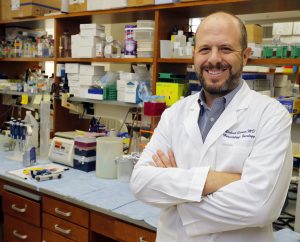
Michael Savona, MD, professor of Medicine and holder of the Beverly and George Rawlings Directorship, leads a lab with multiple ongoing projects to develop new treatments for blood cancers and better understand how they develop. Photo by Steve Green.
“In the same way, the genome has areas that are really important and areas that are less important. If an error happens in an important area of a gene that gives a cell a growth advantage, then you start to get more and more of the cells that have the mutation,” Savona says.
People who have clones with mutations in genes that drive hematologic malignancy and that are present as 2% or more of the blood — but who have no evidence of hematologic disease — are said to have clonal hematopoiesis of indeterminate potential (CHIP).
It’s no surprise that CHIP increases the risk of blood cancers, Savona notes, but it also increases risk of cardiovascular, lung and kidney disease. About 10% of people over age 70 have CHIP, and the incidence increases with age.
“There’s a great chasm between understanding that someone has clonal hematopoiesis and understanding why they go on to develop disease. We have a lot to learn,” he says.
Savona founded a Clonal Hematopoiesis Clinic at VUMC in 2018, and last year he launched the collaborative effort CHIVE (Clonal Hematopoiesis and Inflammation in the VasculaturE). CHIVE brings together experts from multiple medical specialties, genetics, data science and molecular biology to discover how CH contributes to disease.
As part of CHIVE, Vanderbilt investigators are building a biorepository of patient blood samples, giving them the ability to follow patients over time and track changes as they happen.
“We’re also making our best efforts to counsel patients — right now that’s along the lines of ‘I’m not worried about you; I’m kind of worried about you; I’m worried about you,’” Savona says.
Patients who fall into the “I’m worried about you” group may have follow-up appointments every three months to try to catch the earliest signs of a disease such as MDS. And in this rapidly evolving field, as the investigators learn more about the impact of blood changes and develop better treatments, they will be ready to respond more quickly with the right therapies, Savona says.
Detecting clonal hematopoiesis
Xu, whose father passed away shortly after being diagnosed with MDS, is participating in the longitudinal studies.
When she returned to Tennessee in 2014, Xu focused on finding out all she could about MDS. She had begun to think about her own blood-related concerns — an unexplained drop in her white blood cell count below the standard range that had happened when she was in her 40s.
“I just automatically put this together with my dad’s blood issue and thought ‘I should pay attention to this,’” says Xu, who is now 58.
She signed up for MDS Foundation newsletters and decided to attend a seminar for patients and caregivers at the MDS Center of Excellence at VUMC. Savona presented at the seminar, and afterwards, Xu asked him questions and told him about her concerns.
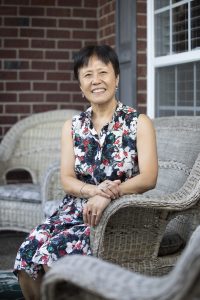
Lianfei Xu. Photo by Erin O. Smith.
“He said, ‘If you’re nervous, why don’t you come see me and we can talk about this and run some tests,’” Xu says. “That was how we started to work together in 2015, and through the years my blood counts have gone up and down, up and down, but because Dr. Savona’s there, I know I have resources and people that really understand this. It’s quite comforting.”
Xu does not have an identified CH mutation, but her low white blood cell count (a diagnosis of ICUS, idiopathic cytopenia of undetermined significance) and her family history support following her more closely, Savona says. If she develops a clonal mutation, she will be at greater risk of blood cancers or other adverse outcomes.
CH mutations are identified by genetic sequencing of blood. For some patients, a CH mutation is incidentally found during genetic testing of a solid tumor with companion blood testing. Other patients get a confusing result on a direct-to-consumer DNA test and then find their way to the CH clinic. Overall though, identifying people with CH is a challenge.
Alexander Bick, MD, PhD, assistant professor of Medicine in the Division of Genetic Medicine, works with Savona in managing CHIVE and has developed an inexpensive and effective test to detect CHIP by focusing on a select panel of genetic mutations.
“Rather than costing several hundred dollars, our test costs less than $10 per sample,” Bick says.
The new test will be valuable for studies using BioVU, Vanderbilt’s unique biobank of DNA samples linked to de-identified electronic health records, along with studies of CHIP in cohorts of patients who have heart, lung or kidney disease.
“We are excited about applying this test as a research tool to identify clonal hematopoiesis in many different patient cohorts at Vanderbilt, and we’re working with colleagues in pathology to think about how it might be deployed clinically,” Bick says.
Impact of CHIP mutations
Bick got interested in clonal hematopoiesis during his graduate studies at Harvard, when he and other investigators were among the first to discover that healthy people with CHIP mutations were at increased risk of blood cancers and cardiovascular disease.
“I found it really intriguing that a mutation you acquired in your blood could cause heart disease,” Bick says. “I also was very curious why only 10% of people, once they reached their 70s, had clonal hematopoiesis. Why not everyone? And of the people who had clonal hematopoiesis, could we understand who would develop blood cancers or heart disease, and why?”
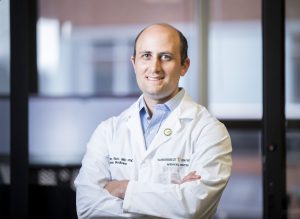
Alexander Bick, MD, PhD, assistant professor of Medicine in the Division of Genetic Medicine. Photo by Susan Urmy.
Bick is using the tools of genetics to explore these questions. In a paper published in Nature in October 2020, he and colleagues looked for inherited causes of clonal hematopoiesis. They analyzed a set of more than 100,000 people whose genomes were sequenced for different reasons and found that about 5,000 had CHIP. Among these people, the researchers identified a handful of inherited genetic mutations that either increased the person’s propensity to acquire mutations or affected the growth of their hematopoietic stem cells.
“The pathways we identified are some of the first clues we have about why some people and not others would have clonal hematopoiesis, and about the biology that underlies it, which is a first step toward finding ways to intervene,” Bick says. “As a program at Vanderbilt, we’re all interested in understanding who’s at risk for cancer and stopping it before people get it.”
In studies using BioVU, Savona’s group is discovering that disease risk is not uniform, even for mutations in the same gene. Patients who have a CHIP mutation in the DNMT3A gene have been considered to be at high risk for cardiovascular disease, but the risk appears to be associated with one mutation, but not another, Savona says.
His team and others at Vanderbilt are evaluating the impact of CHIP mutations in model systems and patient samples.
For example, Savona’s group is using genetic engineering to introduce CHIP mutations into human hematopoietic stem cells, along with a fluorescent marker and a chemical “switch” to turn off the mutant gene, allowing the researchers to test druggability — whether the mutant protein might be a good target for therapeutics. Working with Scott Guelcher, PhD, professor of Chemical and Biomolecular Engineering and director of the Vanderbilt Center for Bone Biology, the researchers have created an ossicle model, a bone marrow mimic that can be populated with cells and inserted into a mouse behind a plastic window.
“We can image with a microscope and watch the behavior of mutant cells in the bone marrow niche, in a live mouse; it’s incredible,” Savona says. “We’re creating a whole library of these mutants and ultimately we’ll be able to test the druggability of any of these CHIP mutations.”
P. Brent Ferrell, MD, assistant professor of Medicine in the Division of Hematology and Oncology, is using single-cell biology approaches to fully characterize gene expression patterns and protein composition in cells with CHIP mutations.
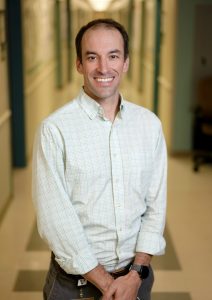
P. Brent Ferrell, MD, left, assistant professor of Medicine in the Division of Hematology and Oncology. Photo by Donn Jones.
Single-cell approaches, including DNA and RNA sequencing, offer opportunities to study patient samples collected over time and detect sequential changes related to disease development.
“Studying the biology of CHIP using patient samples and single-cell assays is not something that a lot of investigators are doing,” Ferrell says. “We’ll have a large cohort of well-annotated CHIP samples in CHIVE. We know that some of the patients will develop malignancy, and we’ll be able to look at their MDS sample and make insightful comparisons about biological differences. I think that’s something that’s really exciting about CHIVE and the biorepository that we’re building.”
At the junction of aging and disease
The links between clonal hematopoiesis, aging and disease could mean that discoveries from the CHIVE initiative have even broader implications than finding ways to prevent blood cancers, Savona says.
“This pre-disease state in the blood has a big impact for me clinically in hematology, but it touches cardiology, pulmonology, endocrinology, renal…all of medicine,” he says. “This is at the juncture of understanding aging and development of disease in a way we haven’t been able to access before. And Vanderbilt is at the tip of the spear.”
The key is learning which blood changes are part of a normal aging process and which ones portend disease — and discovering treatments to change that trajectory.
When Xu reflects on her father’s rapid deterioration and death so soon after his MDS diagnosis, she recalls that he was more tired than usual during her visits prior to 2014.
“My dad was always very active, kind of like a little boy who would never sit still,” she says. “But for about the four previous years, he would say, ‘I’m tired; I need to sit down.’” Xu says she would teasingly scold him, telling him he wasn’t being active enough and his muscles were getting weak.
“I think this disease was with him for several years, and if we knew earlier, it might have been a different situation,” she says. “You should do early prevention or treatment, but the problem is, how do you know. I hope that with research advances and being on Dr. Savona’s radar screen, should I ever develop this problem, he would catch it and treat it early on, or maybe someday even keep it from happening in the first place.”
